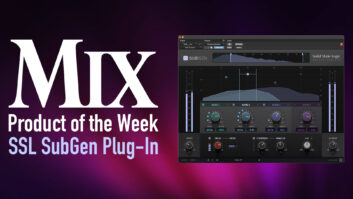For fans of those bands whose music can best be described as pomp rock or heavy metal, an undoubted part of the appeal is the sometimes clownish overstatement of the stage shows. Thanks to the pioneers of the genre and their many imitators, preening singers, pyrotechnic drum solos and rampant posturing both onstage and off have entered the culture as stereotypes.
Unable to resist such a large and tempting target, in 1984 comedy writers Christopher Guest, Michael McKean and Harry Shearer, with director Rob Reiner, wrote and acted in an affectionate, but unflinching satire called, This Is Spinal Tap. Charting the progress of a disastrous U.S. tour by “one of England’s loudest bands,” the so-called rockumentary successfully lampoons the music industry in general and heavy metal in particular. Concert footage, group and individual interviews, candid backstage footage in the best Pennebaker tradition – all contribute to the unflattering but all-too-familiar portrait of artists on the verge. And, like A Hard Day’s Night, which introduced the fabricated slang word “grotty” to an international audience, This Is Spinal Tap has spawned its own vocabulary. Tap aficionados instantly recognize “Goes to 11” as lead guitarist Nigel Tufnel’s vaguely plausible explanation for his inimitable guitar sound, and the hilarious mispronunciation of Dolby as “Dobly” will forever conjure visions of meddling girlfriends and poor album sales postmortems. The fact that the actors wrote and played all of the songs in the movie – Spinal Tap later released an album, 1992’s Break Like the Wind (MCA), and toured to promote it – only blurred the line further between fiction and reality.
Besides a witty script, English accents that Meryl Streep would applaud and some painfully funny sight gags, the movie also includes a slew of fine cameo performances by Patrick MacNee, Anjelica Houston, Fred Willard and Billy Crystal, to name only a few. No sector of the music industry is spared, and the film cannily mocks both the pretensions of the artists and the hypocrisy of their manager and record company. As singer/guitarist David St. Hubbins observes in an unusually coherent moment, “It’s such a fine line between stupid and clever.”
Though This Is Spinal Tap was only a moderate box office success, it quickly found a cult audience on video and is almost required viewing for anyone who makes a living in the music industry. Released briefly as an excellent Criterion Collection DVD in the late 1990s, This Is Spinal Tap quickly went off the market when Criterion lost the Laserdisc and DVD rights to the film to Metro-Goldwyn-Mayer. At one point, the Criterion DVD version was so sought after that single copies went for over $100 at online auctions.
Now, MGM has released a new DVD version of This Is Spinal Tap, featuring a totally remixed 5.1 soundtrack, fresh commentary, trailers and TV spots, four music videos and numerous other goodies. To work on the audio components of the new DVD, MGM enlisted Burbank, Calif.-based Chace Productions. Senior Chace digital stereo products specialist John Blum handled the restoration and computer prep work for the soundtrack, and independent mixer Mark Rozett took care of the mixing duties.
The soundtrack was remixed in the Rick Chace Theatre on a 60-input Lafont Audio Labs Chroma 5.1 console with an Uptown automation package. The THX-certified mixing room features a monitor setup designed to handle all formats from mono through full, discrete 5.1 stereo and includes six JBL 4675-C-8LFs powered by 4,000 watts of Bryston amplification. Dolby SEU-4 and SDU-4 encoding/decoding was used for the Lt/Rt matrixing, and the surround mix was monitored through JBL 8340 high-power surround speakers.
“We were working from the original 2-inch, 16-track `Dobly’ SR analog master that they recorded the show on,” says Rozett. “The original mixers [John Reitz C.A.S., Dave Campbell C.A.S. and Gregg Rudloff] did an excellent job on the mix, so we were starting from very firm ground on the show. We had LCRS stems of both the effects and the dialog, which had been laid out in mono.
“The first thing that John Blum did was No Noise the show. It was in very good shape, so it wasn’t a tedious process. They just cleaned up things here and there and prepped it for me to deal with on the stage. Then we went on the stage with the 16-track master and went through the Chace Surround Stereo box.” The Chace Surround Stereo Processor is a proprietary device that allows the programmer to perform complex steering maneuvers. Combined with psycho-acoustic effects and some spatialization techniques, the processor enhances the audio in a very precise and detailed manner.
“It really brings a show into 5.1 from its original source,” Rozett explains. “It did a really nice job here. Of course, like any device, it is dependent on the person who is doing the programming. In this case, John Blum is probably more versed than anyone on using the Chace Surround processor box. John is also a huge Spinal Tap fan, so that came in handy. John went through the show and programmed it, using the abilities of the box to really take the show from its original form and enhance it, rather than change things dramatically.”
Spinal Tap’s Michael McKean and Harry Shearer, who were present for the mix, were eager to push the dynamics of the soundtrack. “When Harry and Michael came to the stage and started working on the show, we had a lengthy discussion about what the approach should be and we all got on the same page,” states Rozett. “There was the feeling that the documentary nature of the show should be left pretty much intact. Any enhancements of the dialog sequences should, at the most part, be minimal. Where they were really looking to see an enhancement of the show was in the music.”
This Is Spinal Tap lent itself well to being remixed for 5.1. The 1984 Dolby Stereo mix had been subject to the limitations of the medium at that time, including a mono-only surround, subwoofer restrictions and the limitations of the matrix. For the remix, Blum and Rozett were freed of all of those restraints.
“The LCRS music stem that they recorded was, probably for the first time, heard without the Dolby matrix, which means that we were getting four discrete channels rather than the matrixed version of it,” says Rozett. “We did have SDU-4 matrix set up on the stage to listen to the tracks through it and use it, if necessary. For the most part, being freed up from the matrix worked better than re-simulating what the original mixers were hearing. Most of our attention went to listening really discretely like that and making adjustments based on if that caused any different sound than what the original mixers were hearing, because they were hearing it through a matrix, which changed the character of it.”
“Harry and Michael always felt that they never got that visceral impact thing that they envisioned with a live Tap performance, due to the limited dynamic range of a Dolby 2-track mix,” states Blum. “With the dynamic range available with 5.1 in an all-digital format, we were able to kind of make that dream come true. I think they were very happy with that.
“At one point, I asked Harry, `How loud do you guys play onstage?’ Harry kind of raised his eyebrows and said, `Very loud.’ I thought, `Of course, what a stupid question! This is Spinal Tap!'” Blum laughs. “So with that in mind, we were definitely excited to mix the music to give it its full impact. We didn’t deviate hugely, because it was a very nice mix to start with. But we still were able to get a lot of detail out of it. There was a slight re-EQ’ing and re-balancing that all went into it.”
“The guys in the band were very involved in the 5.1 mix,” says Jeffrey Schwarz, Value-Added Producer for the Spinal Tap project. “It was very interesting to watch the guys work, because a lot of their decisions were based on what the fictional director of the movie would do in this case. So if they were making decisions on how loud the music should be, it would naturally be really, really, really loud. That was because Marty Dibergi, the fictional director, would think to himself, `Well I finally have got the money to do a 5.1 mix, and it is about time that we did the movie a lot louder.’ [Laughs] They were kind of mixing in character, too, which was fun to watch. You don’t really ever get to see that happen.”
Rozett shares Blum’s enthusiasm for the sonic-end results of the Spinal Tap musical segments. “They might’ve taken it to the number `11′ for the original movie, but we took it to `12.’ It is huge sounding and exaggerated, but appropriately so,” adds Rozett. “Harry and Michael were very knowledgeable – not only from being fabulous musicians themselves. They were able to guide us, and we were able to use their vision to enhance it in the way they were looking for.”
The mix of Spinal Tap’s “Big Bottom” was especially memorable for Blum, thanks to Shearer and McKean’s humorous riffing. “At one point during `Big Bottom,’ there are three bass guitars and a bass synthesizer all playing low notes, and we were using the LFE channel to extend the low end and dynamics of the track,” recalls Blum. “And I turned around and asked Harry, `Is that enough?’ He said, `Hey, it’s “Big Bottom”! Lard it on!’ That is now my new technical term. They were great guys to work with. I loved doing this, and this was definitely the apex of my restoration career.”






